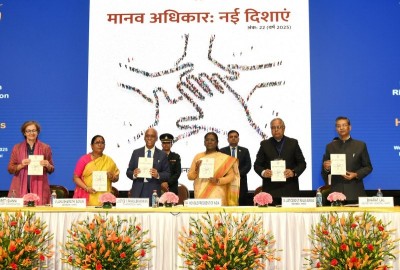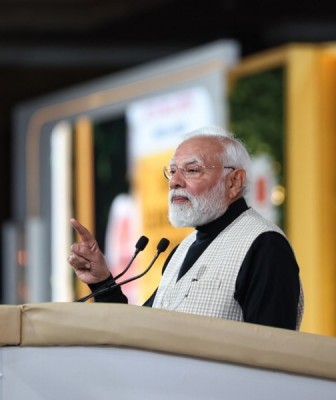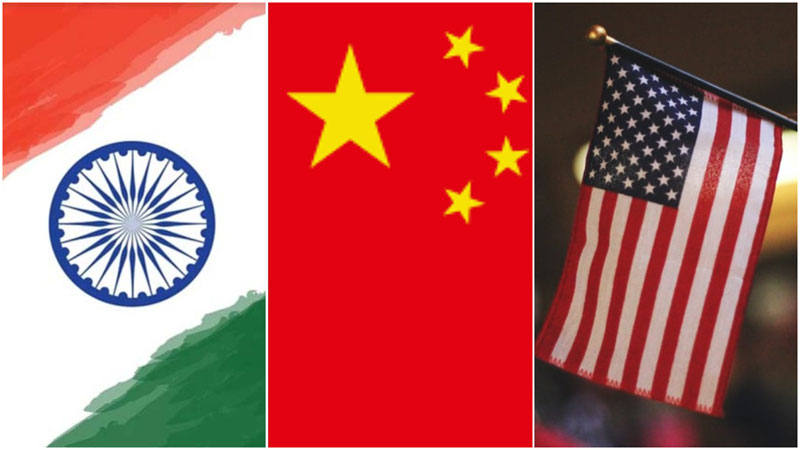 India-China-US
India-China-US
The stalemate on the India-China border and the wooing of India by the United States
Since the gory 15 June clashes between Indian and Chinese troops in the Galwan valley, senior representatives of the two countries have held five rounds of talks aimed at disengagement and de-escalation along the Line of Actual Control (LAC).
The negotiations have yielded some results, with troops of both countries pulling back in some of the contested sectors, but Chinese troops are still present in the Depsang Plains region, Gogra, and the Fingers region along the Pangong Tso.
As brought out in the EFSAS Commentary of 22-05-2020, Pangong Tso was the biggest source of contention.
In the initial phase of disengagement at Pangong Tso, the Chinese moved back from Finger 4 to Finger 5, but continued with their deployment on the ridge line. India is insisting that China move back from Finger 5 to its old position on the Finger 8 spur.
In the face of repeated demands by the Chinese negotiators that India move its troops back from the forward areas, India has refused to consider any de-escalation until the disengagement process through the withdrawal of Chinese intrusions is complete.
Just like in Doklam in 2017, the firmness and resolve displayed by the Indian political and military leadership in the face of the Chinese transgressions have surprised China.
India’s Defence Ministry has assessed in a recent report that “the situation in Eastern Ladakh arising from unilateral aggression by China continues to be sensitive and requiring close monitoring and prompt action based on an evolving situation”.
It postulated that “While engagement and dialogue at military and diplomatic level is continuing to arrive at mutually acceptable consensus, the present standoff is likely to be prolonged”.
This is borne out by the fact that both sides have begun preparing to dig in for the winter despite the harsh climatic conditions that prevail at such high altitudes.
India has mounted a massive logistics and stocking exercise similar to what it does every year to retain its hold over the even more unwelcoming Siachen glacier.
Amidst this impasse, some of the messages emanating from India and China directed at each other have been both informative and interesting. Commenting on a 2 August interview of Indian External Affairs Minister (EAM) S. Jaishankar to the Times of India, the Chinese foreign ministry spokesperson said that the two countries should “make sure differences do not escalate into disputes. I hope India will work with us in the same direction and safeguard overall interests of bilateral relations with concrete actions”.
In essence, what China was suggesting was that India put aside the border issue and focus on the overall bilateral relationship.
Given that China has periodically been needling India at the border and routinely violating agreements reached between the two sides to maintain peace and tranquility there, India has now been bitten enough times to realize the futility, even counter-productivity, of dealing with the border issue in isolation.
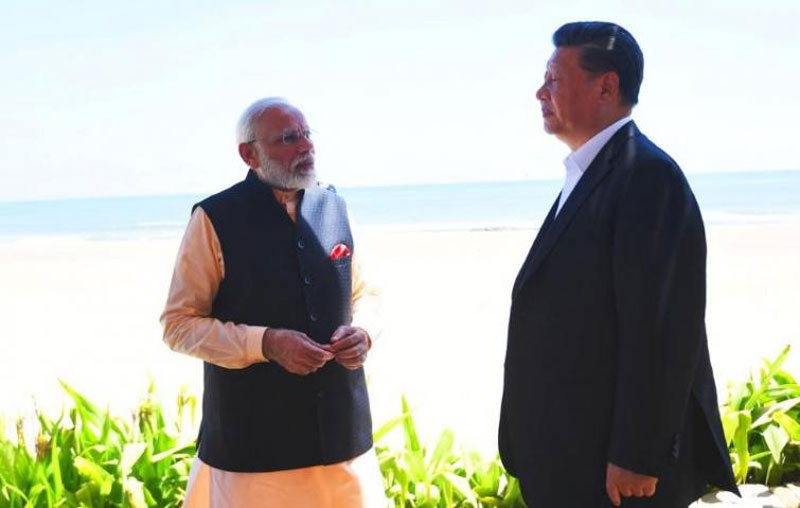
Despite the temptation to take the easy road proposed by the Chinese, India believes that it is now resolute and strong enough to sustain a serious confrontation at the border in order to secure the future from unpredictable and unprovoked acts of aggression by China.
India realizes as well the potential serious consequences of a Chinese intrusion that goes out of hand, as the one on 15 June in Galwan well-nigh did.
That is why Jaishankar categorically underlined in the interview mentioned above that “The state of the border and the future of our ties cannot be separated. That is the reality”.
A recent interview by the Chinese Ambassador to New Delhi Sun Weidong was a vindication of India’s reasoning behind its altered and more stringent position on the border issue.
Speaking at a webinar on ‘India-China Relations: The Way Forward’ that was organized by the Institute of Chinese Studies on 30 July, Weidong said that “there has been an argument in Indian public opinion on the boundary question, which worries me, suggesting the Indian government adjust its policy towards China, and change its stance on issues related to Taiwan, Xizang, Hong Kong and the South China Sea to put pressure on China.”
Xizang is the Chinese name for Tibet. Weidong called on both sides to “correctly analyze and view each other’s strategic intentions, and prevent misinterpretation and miscalculation in a positive, open and inclusive attitude”.
When asked why China did not want to settle the LAC with the exchange of maps, Weidong responded, “The purpose of clarification of LAC is to maintain peace and tranquility. When we look back into history, if one side has unilaterally stated its own perception on the LAC during the negotiations, then that will lead to disputes. That is why this process cannot … move on. I think that this is a departure from the original purpose”.
He added that “the important thing is that we must follow those agreements and continue our discussion and consultation along the diplomatic channels and also among corps commanders, and also find out a way to de-escalate the situation and restore peace and tranquility”.
As per Weidong, therefore, the main issue was for India and China to maintain peace and tranquility on the border in accordance with past agreements and confidence-building measures.
China views its initiation of provocations at the border and then the use of pressure and intimidation against India to urge it to “cooperate” in restoring peace and tranquility as a convenient and useful short-term tactic.
Weidong seemed to indicate that working towards a permanent solution to the LAC was not a priority for Chinese strategic thinkers, who saw more benefit in bogging India down at the LAC whenever China felt the need to do so.
A disproportionate focus on securing the largely barren LAC would cost India substantially and distract it from its preferred concentration on economic development and growth which over the last few decades has contributed substantially towards earning it weight and influence in the international arena. From India’s perspective this was an unacceptable state of affairs.
India understands that its deepening relationship with the United States is a cause of serious concern for the Chinese leadership, especially in these times when Chinese insecurity is at a heightened level given the multifaceted and growing number of international challenges and pressures that it is faced with.
India has demonstrated considerable sensitivity while trying to assure China of the unlikelihood, unless pushed to the brink, of India ganging up with the US and other countries that have been at the receiving end of Chinese belligerence in recent years.
Speaking at a virtual conference on 20 July on the “Geopolitics of opportunity: as the world rebalances, how should India capitalise?” EAM Jaishankar emphasized that India continued to value its independence in the international sphere and that it would never become a part of an alliance system.
He said, “Non-alignment was a term of a particular era and geopolitical landscape. One aspect was independence, which remains a factor of continuity for us”.
He added, “The consequence of repositioning of the United States, that the big umbrella is now smaller than it used to be, has allowed many other countries to play more autonomous roles. It doesn’t affect us as much because we were never part of an alliance system and we will never be. But countries who depended more on the US are finding they have to take a call themselves on many issues”.
Jaishankar, however, clarified that India would not be averse to taking more “risks”, as the world expected it to take a more proactive stance on the “big issues” of the day, including connectivity, maritime security, terrorism, and climate change.
India certainly views joining forces with the US to specifically target China as a risk. It is not really looking forward to exercising such an option despite the apparent Chinese insecurity on this count, or the repeated recent overtures and entreaties of the US.
The contention in the EFSAS Commentary of 03-07-2020 that China would only have itself to blame if India were forced into fully joining a US-led anti-China front, which could prove to be a game changer, still holds as true.
The US, meanwhile, is not sparing any effort in wooing India during its current imbroglio with China. Secretary of State Mike Pompeo during a Congressional hearing on 30 July told the members of the House Foreign Affairs Committee regarding China that “they talk about bringing socialism with Chinese characteristics to the world."
"Claims that they have now made for real estate in Bhutan, the incursion that took place in India, these are indicative of Chinese intentions, and they are testing, they are probing the world to see if we are going to stand up to their threats and their bullying. I am more confident than I was a year ago that the world is prepared to do that. There’s a lot more work to do, and we need to be serious about it," he said.
"Our diplomatic efforts are working and momentum is building to mitigate the threats that the Chinese Communist Party presents”.
Pompeo reminded lawmakers that India had banned 106 Chinese applications that threatened its citizens’ privacy and security. On regional security cooperation Pompeo said, “Our QUAD (Quadrilateral Security Dialogue) – the US, Australia, India, and Japan – has been reinvigorated. We’ve worked hard at this. Our diplomats have done wonderful work. I’m very proud of the progress we are making”.
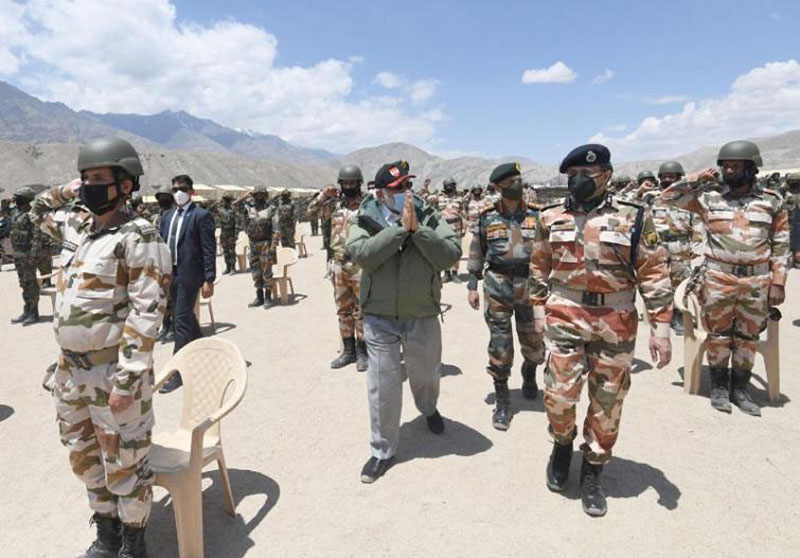
He averred that “the challenge of China demands exertion, energy from democracies – those in Europe, those in Africa, those in South America, and especially those in the Indo-Pacific region”.
Earlier this week, Chairman and Ranking Democrat Member Eliot Engel and Ranking Republican Member Michael McCaul jointly wrote on behalf of the US House of Representatives Committee on Foreign Affairs to EAM Jaishankar and unequivocally held China responsible for the aggression along the LAC in Ladakh.
Saying that they wanted to demonstrate the strong bipartisan support for the India-US relationship, they added, “Members of both parties recognize the impact that a strong US-India partnership will have on the trajectory of the 21st century. As Prime Minister Modi said in February of this year, our ties ‘are no longer just another partnership. It is a far greater and closer relationship’.
"This closer relationship is all the more important as India faces aggression from China along your shared border, which is part of the Chinese government’s consistent pattern of unlawful and belligerent territorial aggression across the Indo-Pacific. The United States will remain steadfast in support of India’s efforts to defend its sovereignty and territorial integrity”.
In early July, White House Chief of Staff Mark Meadows stressed that the US will continue to stand strong in the ongoing conflict between India and China.
He alleged that no one in China's periphery was safe from Chinese aggression. When asked about the US Navy deploying two aircraft carriers in the South China Sea amid the ongoing tensions, Meadows responded, “The message is clear. We're not going to stand by and let China or anyone else take the reins in terms of being the most powerful, dominant force, whether it's in that region or over here. Our military might stands strong and will continue to stand strong, whether it's in relationship to a conflict between India and China or anywhere else”.
Several offers of help from the US to India have been made. Republican Senator Rick Scott in a 2 July letter to Indian Prime Minister Narendra Modi wrote, “Communist China believes that in order for them to be strong, America, India and other freedom loving countries must be weaker.
"They are cracking down on freedom and autonomy in Hong Kong, and continue to threaten Taiwan and India.
"As you continue to stand against Communist China and General Secretary of the Communist Party Xi (Jinping), I want to offer help in any way I can to the Republic of India, the world’s largest democracy and our ally.
The United States will always defend our allies and those fighting for freedom”.
Despite the plethora of US protestations of support, India, as brought out afore, recognizes the risks of wholeheartedly aligning with the US against China.
Be that as it may, India has also made it abundantly clear that it will not accept any solution with China that falls short of restoring status quo ante 5 May at the LAC. In this scenario India’s future course of action hangs in the balance.
While India hopes that the current standoff will be resolved through dialogue, it has also left little doubt about its preparedness for conflict escalation in order to safeguard its territory.
It may, therefore, be the optimal option for India and China to work out a mutually acceptable solution that involves a face-saving Chinese exit. Russia, as India’s traditional partner and China’s newfound ally, could potentially play a useful role in hammering this out.
As for the US, barring a sharp deterioration in India – China ties in the near future that could leave India with little other option, it would serve US interests best if it moved beyond general assurances of standing by India and spelt out exactly what it was willing to offer to attract India enough to take the plunge, and the risk.
Support Our Journalism
We cannot do without you.. your contribution supports unbiased journalism
IBNS is not driven by any ism- not wokeism, not racism, not skewed secularism, not hyper right-wing or left liberal ideals, nor by any hardline religious beliefs or hyper nationalism. We want to serve you good old objective news, as they are. We do not judge or preach. We let people decide for themselves. We only try to present factual and well-sourced news.





